Menu
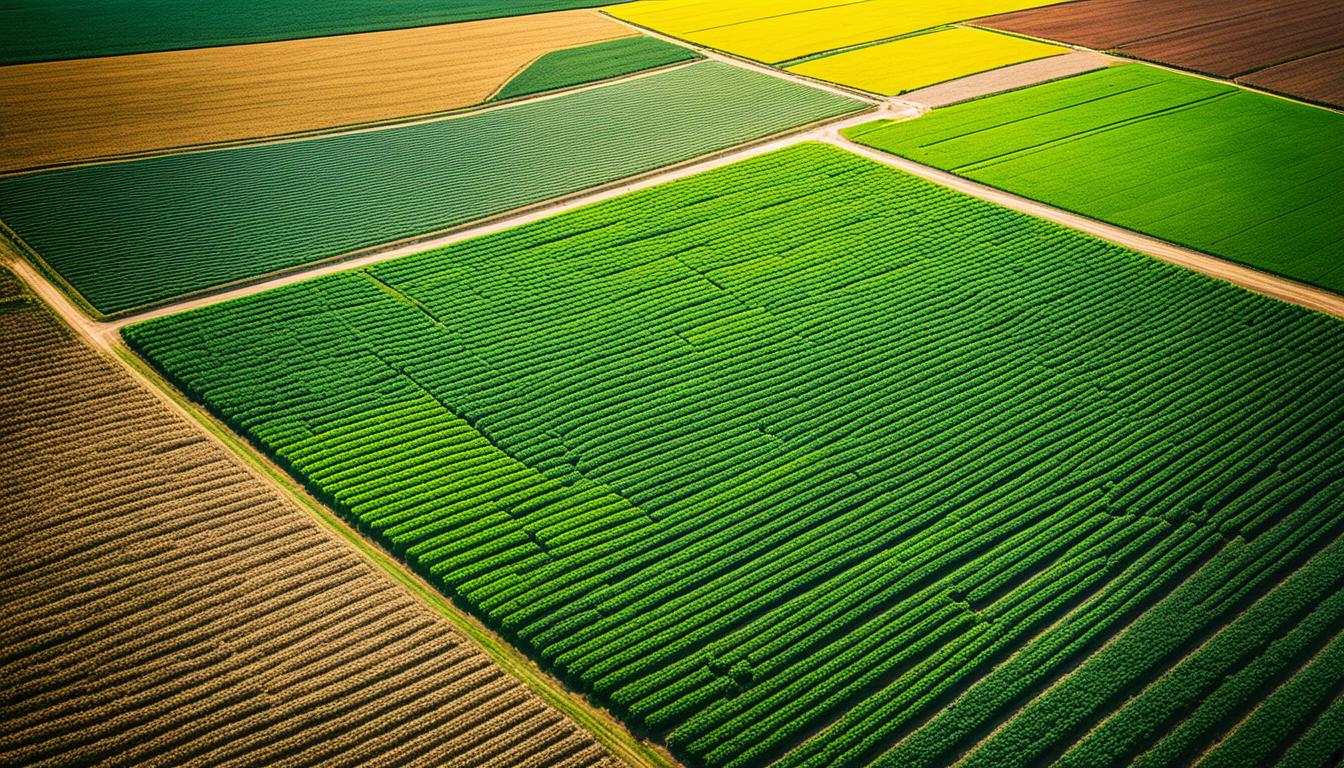
Did you know Bob Deck’s 7,000-acre vineyard produces 2 to 4 million wine cases each year? It’s thanks to using precision agriculture technologies. They change how we farm on a bigger scale than ever before.
The use of precision agriculture is growing worldwide. Case studies are key to understanding its success. Experts point to the work of Dr. Wayne Howard from California Polytechnic State University. He shows the big difference GPS, remote sensing, and GIS make in running farms better. By blending high-tech methods with old ways, farms work smarter and decisions are sharper.
These stories from the field show the true advantages of doing research in precision farming. They are a must-read for anyone in agriculture.
Precision agriculture uses the latest tech like GPS, GIS, and remote sensing to manage farms. It focuses on the small changes in fields, boosting crop yield and cutting down harm to the environment. This approach blends old and new practices, using data to make better farming choices.
Bob manages 7,000 acres of vines for his company, producing up to 4 million cases of wine. By investing in GIS and getting images from remote sensing, the vineyard has improved a lot. Bob now takes fewer soil samples but from more specific areas.
Initially, the whole vineyard seemed to need more compost. But, with careful sampling, only 3-4 acres really did. This shows how using data can make farming more accurate and effective.
Perry James has set up six weather stations at Shippy Vineyards to closely track the weather. These stations send detailed data about weather conditions to a computer every 15 minutes. This data helps make better decisions for the vineyard.
The weather stations also have a frost alarm. This alarm calls the supervisor if there’s a risk of frost. It’s an example of how new tech and detailed data can improve farming.
In Missouri, getting accurate GPS signals is very important for precision agriculture. Corrected GPS signals, thanks to differential correction, are much more precise. This precision is vital for tasks like soil sampling, as it allows for focusing on small, specific areas.
Using a detailed grid for soil sampling, like a 2-acre grid, makes the process more exact. Satellite data is also used to monitor crop health and identify problems early. This helps in making plans that use agricultural chemicals better.
GPS and GIS are changing how we manage vineyards. With their help, growers can analyse and plan their work in detail. This leads to better outcomes in their farming.
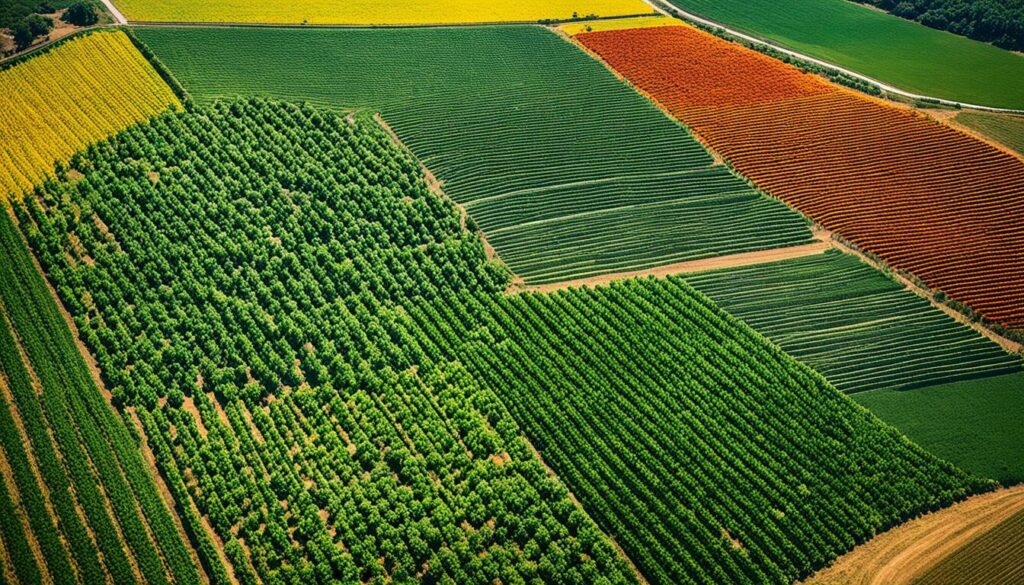
Bob Deck’s vineyard in California’s Central Coast shows the power of GPS and GIS. His team uses these tools to create precise maps. They then use these maps to target specific areas for better soil and brix sampling. Thanks to this, they’ve improved grape quality and yield while cutting back on unnecessary costs.
Applying GPS and GIS in Bob Deck’s vineyard brings clear benefits and some tough challenges:
The use of remote sensing has also made a big difference. It helps understand and manage variations within vineyards better. By combining ground-based sensors with GNSS, they can closely monitor vine canopies. This leads to smart, targeted actions that save money and benefit the environment.
In summary, farms like Bob Deck’s show us how cutting-edge technology is making a big difference in agriculture. They set a great example for using technology to farm in ways that are smart, eco-friendly, and effective.
Remote sensing is key in improving precision agriculture. It offers detailed images, showing field conditions accurately. By telling crops apart from each other, it helps improve how we look after them.
This tech makes it easier to check on big areas of land. It helps farmers look closely at their crops. This means less guessing and more exact methods in agriculture.
Using remote sensing in farming can be pricey. Let’s say a vineyard covers 7,000 acres. It might need to spend $7,000 in a season for this technology. But, this cost is worth it. It makes managing the land more precise.
For example, in the past, a 20-acre vineyard would need the same fertilizing everywhere. But with remote sensing, only 3-4 acres might need it. This example shows how precise and money-saving this tech can be.
| Aspect | Cost/Value |
|---|---|
| Implementation of PA System | Approximately $22,000 |
| Remote Sensing (per acre) | Approximately $1 |
| Total Acreage Managed | 7,000 acres |
| Wine Yield | 2-4 million cases annually |
Remote sensing in farming isn’t just about aerial images. It also involves GPS, GIS, and analysing big data. These together collect and understand lots of info. This data is used for things like managing water use, deciding how much fertiliser to use, and preventing pests.
“Monitoring technologies like remote sensing allow us to detect changes in field conditions more quickly and accurately, which is essential for maximising crop yield and sustainability.” – Dr. Wayne Howard
The use of remote sensing data varies by the size and aim of each farm. It’s tailored to help with specific needs. For example, it makes it easier to use the right amount of fertiliser or spot diseases early.
Shippy Vineyards in the Salinas Valley have 6,000 acres of vineyards. They use a lot of remote sensing to watch over their land. This has changed how they manage their crops. Now, they can make decisions based on detailed, up-to-date information.
Variable Rate Irrigation (VRI) is a key player in precision farming. It uses data to make sure crops get just the right amount of water. This means no water is wasted.
In Georgia, VRI was used to grow more cotton with less water. It worked impressively well. Cotton yield bumped up by 8%. At the same time, water use dropped by 15%.
These results show VRI’s power to save water and boost farm output. In various locations, water saving was between 8% and 36% over two years.
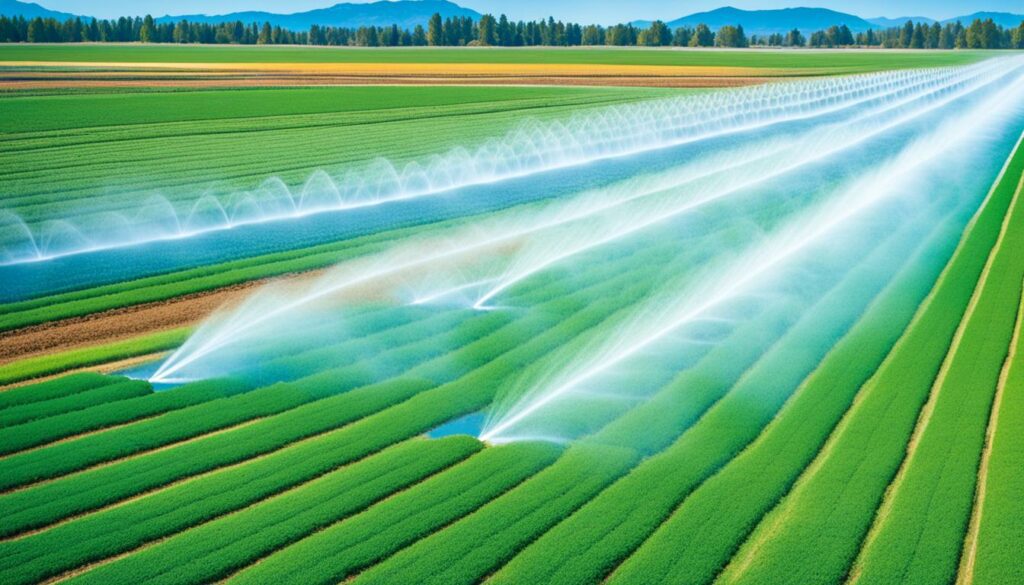
The success of VRI was clear when used on a 750-m centre pivot at a dairy farm. The investment paid off in just one year. Case studies like this offer valuable lessons for using agri-tech in smart ways.
VRI uses top-notch tools like real-time soil moisture watchers. These help water less go to waste. Tests showed that VRI is as good as using the same amount of water everywhere (URI).
Farmers are getting into VRI more, thanks to fancy tools like EM sensors. By checking soil correctly, they can water plants exactly how much they need. This keeps things efficient.
VRI also lets you grow different crops with the same water sprayer. But, we still need to learn how well it keeps water in certain soil types. And how this tech links to soil differences.
| Aspect | Traditional Irrigation | VRI |
|---|---|---|
| Water Savings | 0% | 8%-36% |
| Yield Impact | Standard | Up to 8% increase |
| Investment Payback Period | N/A | Within 1 year |
| Environmental Impact | Higher nutrient leaching | Reduced nutrient leaching |
Agri-tech studies show VRI is a winner. It saves water and grows more crops. It’s a big step forward in smart farming.
Using new farming methods, like crop sensing and targeted spraying, now brings big benefits. In Australia, drones with special cameras help farmers spot areas with lots of bugs precisely. This cuts down herbicide use by 90%. It saves money and helps the environment by reducing chemical runoff.
Australia shows how well this new farming can work. Farmers use drones with cameras and sprayers to fight weeds in just the right places. This has cut down herbicides by 90%, proving the method’s success.
The good effects on the environment are big. Less chemicals mean less harm to our land and water. This keeps our ecosystem healthy. Plus, less herbicides mean big savings for farmers. By using these new tools, farm productivity goes up while taking care of nature.
This shows that mixing technology with traditional farming can be a win-win. It’s good for making money and being kind to the planet.
Yield mapping and forecasting are key in today’s farming. They help make agricultural projects work well. In India, using new tech in sugarcane farming shows how far we’ve come.
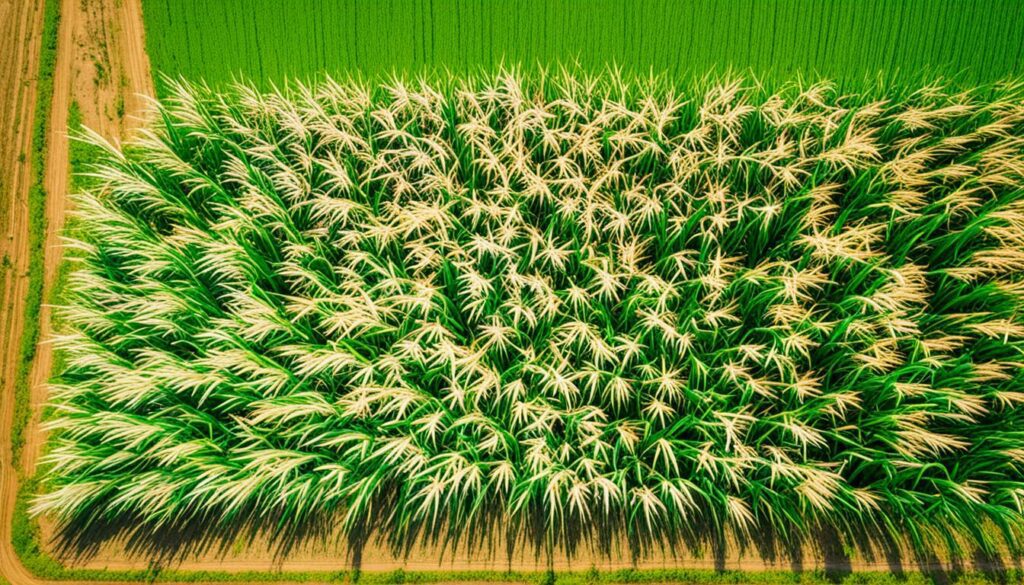
Advanced tech like GPS, sensors, and AI has changed sugarcane farming in India. Yield mapping looks at how crop yields vary across fields. This method gives farmers better insights, especially in dealing with changing weather and rainfall.
The use of tools like CYPA has greatly improved the accuracy of yield forecasts for sugarcane. DecisionTreeRegressor, RandomForestRegressor, and ExtraTreeRegressor have high scores (0.9814, 0.9903, and 0.9933). This shows how machine learning and big data boost our ability to predict crop yields.
Yield mapping and forecasting have many practical uses. They help farmers plan better, use resources smarter, and make choices based on good data. Adding active learning makes CYPA even better by needing less training data.
These tech advances lead to better crop management. They increase productivity and help ensure food supply. Plus, they provide tools for farmers to predict yields under different climate conditions and deal with issues like droughts, floods, and pests.
In short, understanding field yield variations well can help farmers succeed. Embracing new tech is critical. It shows the important role precision agriculture tech has in farming’s future.
| Algorithm | Predictive Accuracy |
|---|---|
| DecisionTreeRegressor | 0.9814 |
| RandomForestRegressor | 0.9903 |
| ExtraTreeRegressor | 0.9933 |
*Soil health monitoring* is at the forefront of precision agriculture today. In Kenya, maize farmers have seen great improvements, with a 30% increase in their yield. This change was made possible by using advanced *agricultural technology*. It offers farmers advice specifically to improve soil health.
Advanced technologies in Kenya have vastly improved maize farming. Tools give detailed information on soil, moisture, and nutrients. This helps farmers use fertilisers and water more wisely. As a result, crop production gets better.
The future for soil health monitoring looks good. New, cheaper technologies and better data analytics are coming. These will make *precision agriculture* easier and more effective. This means farmers can use real-time data to make sustainable choices and improve soil. Also, * agricultural technology case studies* show how precision farming is growing food around the world.
Look at this comparison table to see how soil health monitoring technologies help maize farming:
| Technology | Cost | Impact on Yield | Efficiency |
|---|---|---|---|
| Soil Probing | £5,000 per unit | 20-30% | High |
| Remote Sensing | £1 per acre | 10-15% | Moderate |
| Data Analytics | £3,000 per system | 15-20% | High |
Precision agriculture in looking after livestock has started a new chapter in farming. This approach uses sensors and cloud tech for better oversight. It’s making a big difference in how farmers look after their animals, keeping them healthy and more productive.
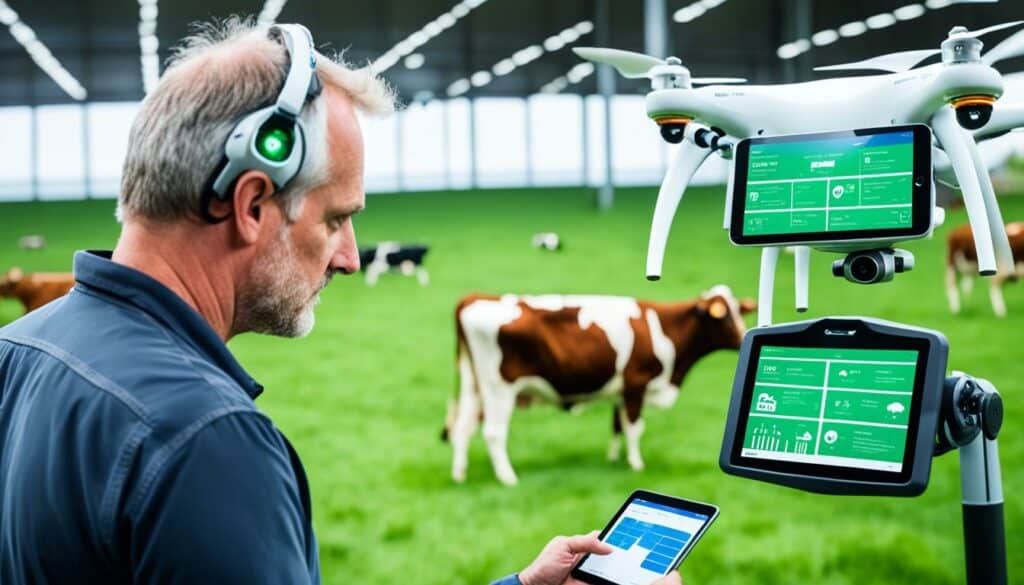
In Ireland, dairy farming is seeing big benefits from these new methods. Now, cattle wear special collars that send data to the cloud. This helps farmers keep an eye on their cows better. Since starting, milk production has got 10% better.
With sensors always checking on the cattle, quick actions can be taken if needed. This is good for the cows and for the farm’s productivity.
Many new tech tools are driving the success of precision agriculture. This includes:
Reports from the European Commission show that these methods are not just good for more output. They also mean farming in a more Earth-friendly way. By using these techs, farmers can produce more while using fewer resources.
| Study Year | Technology Implemented | Outcome |
|---|---|---|
| 2003 | Sensor-based collars | Initial trials and data collection |
| 2010 | Cloud platforms integration | Real-time data analysis |
| 2015 | Smart irrigation systems | Optimised pasture conditions |
| 2021 | Automatic feeding systems | 10% increase in milk production |
The road ahead for precision agriculture is bright. We expect to see even more progress in using sensors and data. This will keep helping our farmers do better in looking after their livestock and the land, highlighting the big impact of precision farming.
The economic impacts of precision agriculture reach far. They affect both individuals and the big agricultural sector. In Australia, only 3% of grain growers use precision technology now. But those who do see big financial gains.
Paying for tech like 2cm GPS can cost about $60,000. Different case studies show costs from $17,300 to $75,000. To make those investments worthwhile, the profit needed can be under $5 per hectare. This shows how using data can make farming more profitable.
Studies look at farms from 1,250 to 5,800 hectares, growing wheat as well as other crops. After using tech like guidance systems and auto-steer for 2 to 10 years, they find big financial boosts. This is seen through higher profits and better farming efficiency.
| Technology | Investment Cost | Break-Even Gross Margin Increase |
|---|---|---|
| GPS Auto-Steer | $60,000 | <$5/ha |
| Variable Rate Fertilised | $17,300 – $75,000 | Varied |
| GreenSeeker | Included in packages | Varied |
Precision farming saves money on crops like winter wheat and sugar beets. These savings make farms more financially secure. They help farms be more efficient in the long run.
Precision farming boosts yield while saving on costs. It makes the most of what’s used and spends less. This smart farming helps both farmers and the whole agriculture industry.
Precision agriculture is crucial for making farming greener. By using advanced tech, farmers increase crop yields by 4%. This shows how these methods can grow more food without harming the planet.
Those who use precision farming see big improvements. For example, they place fertilisers more efficiently, cutting down on waste. They also use fewer chemicals, which is better for the environment. Plus, there’s less need for fossil fuels and water, helping farm practices be more sustainable.
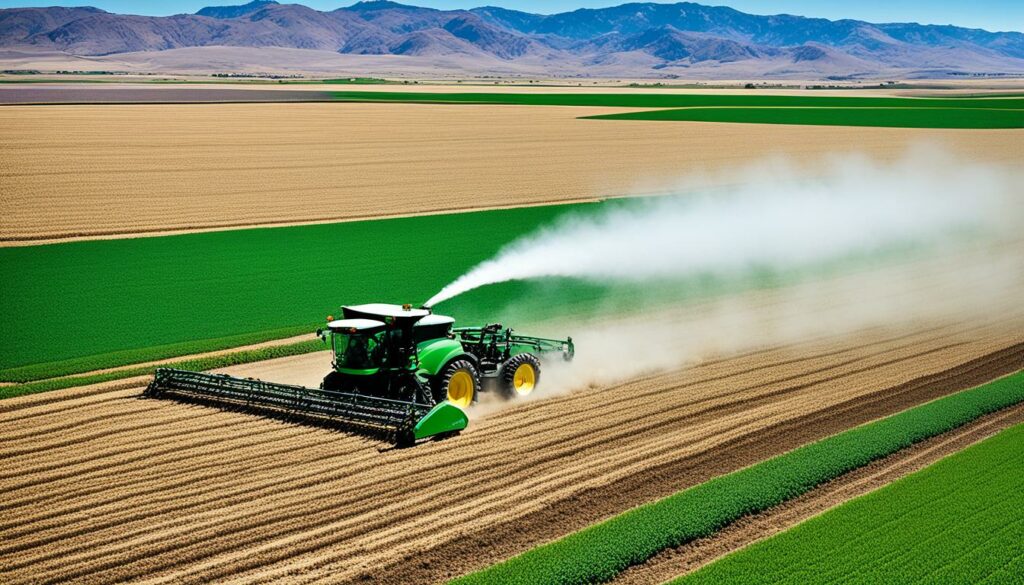
There’s still more to discover in precision farming research. Scientists believe we can boost productivity by 6% and make fertilisers 14% more effective. This could lead to even better results for our planet.
| Metric | Improvement Achieved | Potential Improvement |
|---|---|---|
| Crop Production | 4% | 6% |
| Fertiliser Efficiency | 7% | 14% |
| Herbicide/Pesticide Use | 9% | 15% |
| Water Consumption | 4% | 21% |
| Fossil Fuel Usage | 6% | 16% |
Thanks to these methods, we’ve saved a lot of land and fuel. They’ve also cut down on greenhouse gas emissions. With more farms using these high-tech tools, we could stop even more pollution.
One great success story is Lipman Family Farms. They use less water, saving 66 million gallons each year. Their smart planting beds help save even more water and cut pollution from farming.
These stories show how important precision farming research is. It’s changing the face of farming, making it better for the environment. This means a cleaner, greener future for agriculture.
The world’s population is growing, leading to a bigger need for farming. We must use our land and water wisely. By using data and technology on the farm, we can make every drop of water count and every inch of land productive. Many projects show us how using data wisely can make farming better for all of us.
Leading companies like John Deere and The Climate Corporation are making big steps in farming technology. In the Netherlands, adding smart technology to dairy farms boosted milk by 15%. And in Iowa, smarter use of technology in corn fields cut fertiliser use by 15%. This helped the environment and boosted crop growth by 10%. It shows how valuable technology and data can be on the farm.
Successful farm projects teach us that using data well is key to making good farm decisions. They used cutting-edge tools like sensors and satellites to collect data in real time. This helped farmers make choices that cut risks and improved how much they grew.
Vineyards cutting back on pesticides by 30% by using data to fight pests is a great example. Storing this data safely is also important. Whether it’s in a local database or in the cloud, keeping data safe makes farms better. It helps them produce for the long haul while looking after the environment.
In conclusion, these farm projects are proof that data and technology are changing farming for the better. More tech and better use of data promise to keep improving farming. This will help farms use resources well, grow more, and be more profitable.
In cities with lots of people and little room, precision urban farming shines. It uses small spaces efficiently to grow food. A key method is vertical farming, which stacks plants high to save space.
Vertical farming is changing how we make food in cities. It stacks crops high to make the most of space. This approach, along with things like hydroponics and aeroponics, cuts the need for lots of land.
It also makes urban food production more secure.
Singapore is a leader in urban farming with its vertical hydroponics. These systems use almost no water. They show how farming can be efficient with the right technology.
The farms in Singapore use LED lights and smart sensors. These tools help farmers control the environment for their plants. This means healthier crops that grow well.
Thanks to tech and farming coming together, Singapore grows plenty of leafy greens with little water. This is a model for other cities to follow. It shows how precision urban farming can help feed the world.
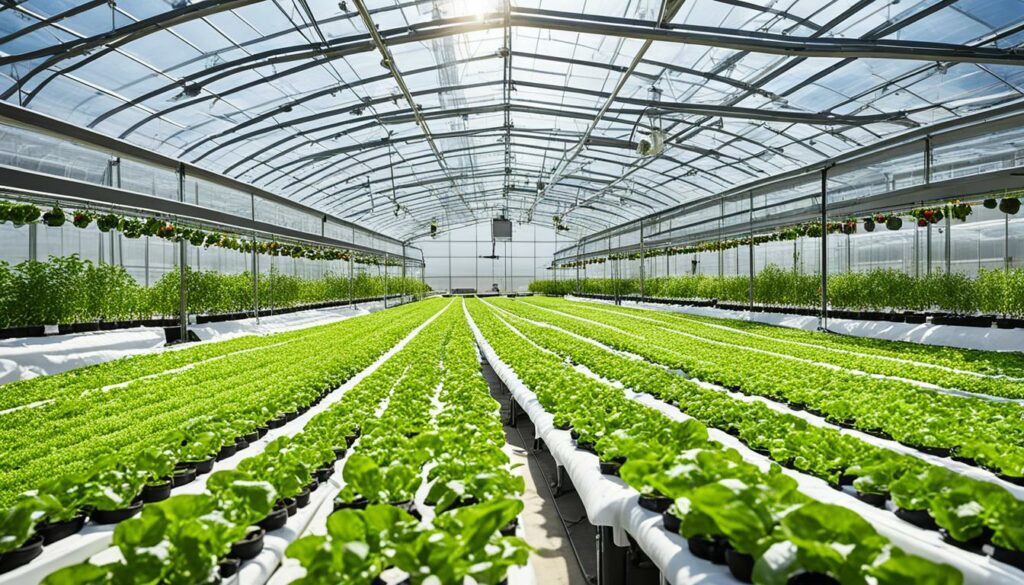
| Technique | Location | Impact |
|---|---|---|
| Variable Rate Irrigation (VRI) | Georgia, USA | 8% increase in cotton yield, 15% reduction in water use |
| Crop Sensing and Spraying | Australia | Reduced herbicide use by 90% |
| Sugarcane Yield Mapping | India | 20% increase in forecasting accuracy |
| Soil Health Monitoring | Kenya | 30% increase in maize yield |
| Livestock Tracking | Ireland | 10% increase in milk production |
| Vertical Hydroponic Systems | Singapore | 95% less water usage |
In the world of precision agriculture, many success stories show how using technology smartly can bring big benefits. This includes getting more from our equipment and making better use of our resources.
Take Bob Deck’s vineyard in California for example. He watches over 7,000 acres of vines that produce 2-4 million wine cases a year. His $22,000 precision system lets him use high-tech GPS and computers. This setup helps him choose where to apply fertiliser and to check how much wine he can expect. With the help of aerial photographs that cost about $1 an acre, Bob can really look after his vines. This approach means he now uses fertiliser more efficiently in his vineyard.
Perry James’ Shippy Vineyards is another great case. Six weather stations there keep an eye on the weather to protect from frost. They take in temperature, humidity, and wind every 15 seconds. Then they send average readings every 15 minutes to supervisors. This careful measuring keeps crops safe and helps them grow better.
In Australia, about three in every hundred grain farmers are using precision farming tools. Their spending on these tools varies, from $17,300 to $75,000. Those who started early prefer GPS systems that guide big farming vehicles accurately. These systems can be pricey at around $60,000, but they help a lot.
Out in Western Australia, farms that grow grain cover between 2300 and 3600 hectares. They only use about 1000 to 1700 hectares each year. Upgrading to precision agriculture doesn’t need a big jump in profit to be worth it, maybe just an extra $5 to $6 per hectare. However, it does lead to better crops and wiser use of resources.
Studies worldwide have shown the power of precision farming. In Georgia, USA, using smart watering systems raised cotton harvests by 8% while reducing water use by 15%. Over in Australia, drones with specialised cameras and sprayers cut down herbicide use in wheat fields by 90%.
Elsewhere, in India, a firm made sugarcane yield predictions 20% more accurate with help from satellites and AI. In Kenya, maize farming saw a 30% boost thanks to advice from a special farming app and soil tests.
Not forgetting about dairy farming, in Ireland a dairy farm raised milk production by 10%. They did this by tracking their cows’ health and movements with a smart collar system and online platform.
These are just a few examples. They all show how choosing the right technology can change farming for the better everywhere. Continuing to explore precision farming will surely lead to more sustainable and efficient farming practices all over the globe.
| Country | Case Study | Outcomes |
|---|---|---|
| USA (Georgia) | Variable Rate Irrigation in Cotton Farming | 8% yield increase, 15% water use reduction |
| Australia | Drones for Targeted Herbicide Application | 90% reduction in herbicide use |
| India | AI-Powered Sugarcane Yield Forecasting | 20% increase in forecasting accuracy |
| Kenya | Soil Health Monitoring in Maize Farming | 30% yield improvement |
| Ireland | Dairy Farming Livestock Tracking | 10% increase in milk production |
Precision agriculture offers many benefits, but not everyone is using it. The U.S. Department of Agriculture (USDA) says only 27 percent of U.S. farms used it in 2023. There are various reasons why adoption rates are low in farming.
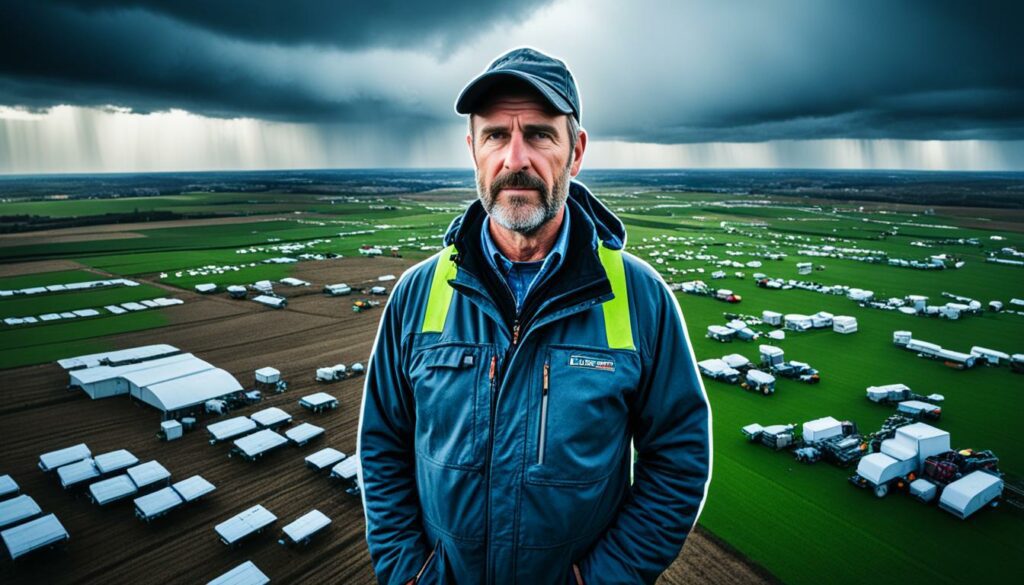
High initial costs are a major hurdle in precision agriculture. To set up things like GPS yield monitors and remote sensors, farmers need to spend a lot. Between 2017 and 2021, the USDA and NSF supported the field with about $200 million. However, this help was not enough, and many farmers still find it hard to invest. For small farms, the high cost of buying and maintaining such technology might seem too risky.
Getting used to the new technology also takes time. Farmers must learn to use equipment and process data. They also have to keep learning to make the most of this tech. Learning to use these tools can be hard because they don’t always work well together.
Addressing the issues of precision farming needs help from many sides. We can make things better by changing policies, teaching farmers, and supporting them financially. Important goals include making technology easier to use, measuring its benefits, and boosting research and data sharing.
The world of precision agriculture is about to change, thanks to new tech like AI and machine learning. These new tools will make farming smarter by offering better insights and models.
AI and machine learning will be crucial in the future of farming. These tools will help farmers analyse data better and get insights they can act on. For example, they can find patterns in big data to make more precise forecasts and improve how they grow crops.
But, the future of farming is not just about AI and machine learning. It includes things like systems that can adapt to field conditions in real-time. It’s also about more than just growing crops. There will be new ways to look at how farming affects the economy and the environment.
Key areas of focus for farming tech evolution include:
But, the adoption of this tech also depends on political and user issues, as shown by Zhang et al. (2002) and Griffin et al. (2004). They say we need good policies and a focus on what farmers need to make these technologies popular worldwide.
For more details on what the future of farming might look like, check out the full analysis by experts in this field.
We’ve seen how important it is to add high-tech tools in farming. It boosts how much we grow things while keeping the land healthy. In Australia, only a few farmers use these tools now. But many more could start using them to make their work better.
Farmers who start early spend a lot to get tools like GPS for their tractors. These can guide tractors very accurately across fields. This may cost around $60,000. Still, these tools save a lot of money in the long run. They make sure farmers don’t waste seeds, fuel, and time.
Tools like GPS for farmers are not cheap. But they really help save costs in the long term. They also make farms more efficient. With these tools, farmers can use less of everything but still get good crops. They can even help the land by using less harmful chemicals.
This new way of farming also helps the planet. It cuts down on bad stuff that could get into the water or air. Thanks to new farming tools, many think farming will change a lot in the future. Farmers can now use science to know what’s best for their fields. They can grow more things, not harm the planet, and still make a living.
Precision agriculture combines high-tech tools with traditional farming. It uses GPS, GIS, and remote sensing to monitor fields closely. By doing this, farmers can grow more crops and harm the environment less.
Bob Deck’s vineyard in California’s Central Coast uses GPS and GIS. They make detailed maps of the vineyards. This mapping helps them to sample soil and grapes precisely, use resources better, and cut back on unnecessary products.
Remote sensing gives detailed maps of fields from above. This lets farmers see where crops differ. They can then manage these parts more accurately. This helps a lot, especially on big farms.
VRI changes how much water is given to crops, depending on the field. Its use in Georgia improved cotton’s yield by 8%. It also cut water use by 15%. This shows it helps crops grow while being more efficient with water.
In Australia, drones find which parts of wheat fields need treatment using special cameras. This high-tech method has cut the use of weed killer by up to 90%. It protects the environment and saves money.
Yield mapping uses GPS and AI to see how well crops are doing. In India, sugarcane farmers use this to plan better and manage their crops effectively. This has helped them get better at predicting how much they will harvest.
Soil health tools give farmers advice on how to make the soil better. In Kenya, maize growers improved their harvest by 30% with this help. They used sensors and smart advice to manage their soil well.
In Ireland, dairy farms watch their cows with smart collars and online platforms. This has upped milk production by 10%. It shows how precision farming can even help with looking after animals.
Precision farming can really help farms do better financially. By using data and new methods, they can save money and grow more crops. This is good for them and for the whole farming industry.
This farming method is good for the planet. It uses fewer resources and causes less pollution. It lessens soil damage, saves water, and avoids spreading too many chemicals.
Companies like John Deere and The Climate Corporation lead the way. Their tech makes farms more efficient and cheaper to run. This shows that using data can really make a difference in farming.
Singapore’s vertical farms use very little water thanks to high-tech growing systems. They control light, water, and nutrients precisely. This could change how cities grow food, using less space and resources.
Getting into precision farming is not easy. It can cost a lot and farmers have to learn new skills. This can be tough for those wanting to try these new methods.
The future will see more AI and machine learning in farming. This will make farming smarter and more efficient. It could change how we grow food, making use of new technology to get better crops.